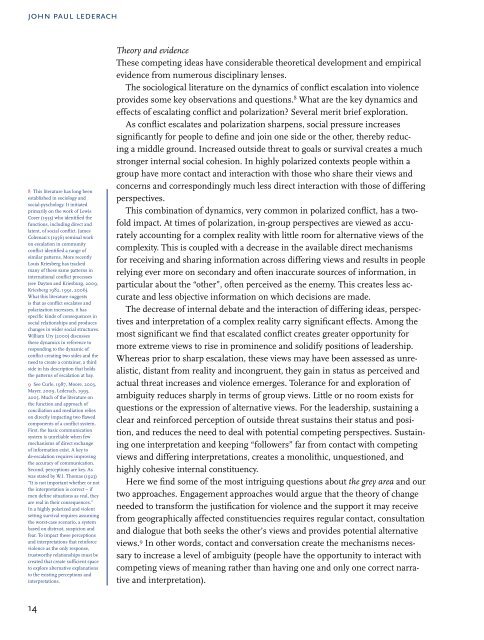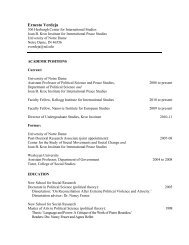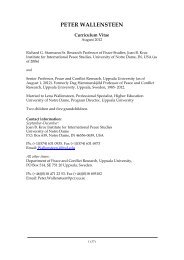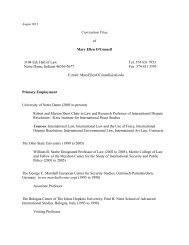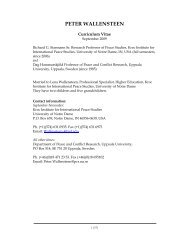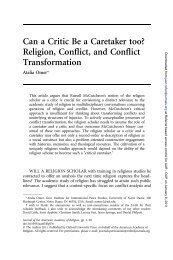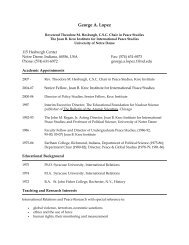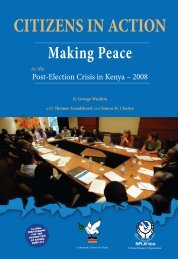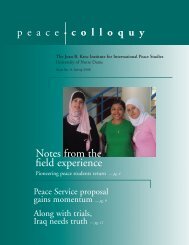Somalia: Creating Space for Fresh Approaches to Peacebuilding
Somalia: Creating Space for Fresh Approaches to Peacebuilding
Somalia: Creating Space for Fresh Approaches to Peacebuilding
Create successful ePaper yourself
Turn your PDF publications into a flip-book with our unique Google optimized e-Paper software.
john paul lederach<br />
8 This literature has long been<br />
established in sociology and<br />
social-pyschology. It initiated<br />
primarily on the work of Lewis<br />
Coser (1955) who identified the<br />
functions, including direct and<br />
latent, of social conflict. James<br />
Coleman’s (1956) seminal work<br />
on escalation in community<br />
conflict identified a range of<br />
similar patterns. More recently<br />
Louis Kriesberg has tracked<br />
many of these same patterns in<br />
international conflict processes<br />
(see Day<strong>to</strong>n and Kriesburg, 2009,<br />
Kriesberg 1982, 1991, 2006).<br />
What this literature suggests<br />
is that as conflict escalates and<br />
polarization increases, it has<br />
specific kinds of consequences in<br />
social relationships and produces<br />
changes in wider social structures.<br />
William Ury (2000) discusses<br />
these dynamics in reference <strong>to</strong><br />
responding <strong>to</strong> the dynamic of<br />
conflict creating two sides and the<br />
need <strong>to</strong> create a container, a third<br />
side in his description that holds<br />
the patterns of escalation at bay.<br />
9 See Curle, 1987, Moore, 2003,<br />
Mayer, 2009, Lederach, 1995,<br />
2005. Much of the literature on<br />
the function and approach of<br />
conciliation and mediation relies<br />
on directly impacting two flawed<br />
components of a conflict system.<br />
First, the basic communication<br />
system is unreliable when few<br />
mechanisms of direct exchange<br />
of in<strong>for</strong>mation exist. A key <strong>to</strong><br />
de-escalation requires improving<br />
the accuracy of communication.<br />
Second, perceptions are key. As<br />
was stated by W.I. Thomas (1923)<br />
“It is not important whether or not<br />
the interpretation is correct – if<br />
men define situations as real, they<br />
are real in their consequences.”<br />
In a highly polarized and violent<br />
setting survival requires assuming<br />
the worst-case scenario, a system<br />
based on distrust, suspicion and<br />
fear. To impact these perceptions<br />
and interpretations that rein<strong>for</strong>ce<br />
violence as the only response,<br />
trustworthy relationships must be<br />
created that create sufficient space<br />
<strong>to</strong> explore alternative explanations<br />
<strong>to</strong> the existing perceptions and<br />
interpretations.<br />
14<br />
Theory and evidence<br />
These competing ideas have considerable theoretical development and empirical<br />
evidence from numerous disciplinary lenses.<br />
The sociological literature on the dynamics of conflict escalation in<strong>to</strong> violence<br />
provides some key observations and questions. 8 What are the key dynamics and<br />
effects of escalating conflict and polarization? Several merit brief exploration.<br />
As conflict escalates and polarization sharpens, social pressure increases<br />
significantly <strong>for</strong> people <strong>to</strong> define and join one side or the other, thereby reducing<br />
a middle ground. Increased outside threat <strong>to</strong> goals or survival creates a much<br />
stronger internal social cohesion. In highly polarized contexts people within a<br />
group have more contact and interaction with those who share their views and<br />
concerns and correspondingly much less direct interaction with those of differing<br />
perspectives.<br />
This combination of dynamics, very common in polarized conflict, has a twofold<br />
impact. At times of polarization, in-group perspectives are viewed as accurately<br />
accounting <strong>for</strong> a complex reality with little room <strong>for</strong> alternative views of the<br />
complexity. This is coupled with a decrease in the available direct mechanisms<br />
<strong>for</strong> receiving and sharing in<strong>for</strong>mation across differing views and results in people<br />
relying ever more on secondary and often inaccurate sources of in<strong>for</strong>mation, in<br />
particular about the “other”, often perceived as the enemy. This creates less accurate<br />
and less objective in<strong>for</strong>mation on which decisions are made.<br />
The decrease of internal debate and the interaction of differing ideas, perspectives<br />
and interpretation of a complex reality carry significant effects. Among the<br />
most significant we find that escalated conflict creates greater opportunity <strong>for</strong><br />
more extreme views <strong>to</strong> rise in prominence and solidify positions of leadership.<br />
Whereas prior <strong>to</strong> sharp escalation, these views may have been assessed as unrealistic,<br />
distant from reality and incongruent, they gain in status as perceived and<br />
actual threat increases and violence emerges. Tolerance <strong>for</strong> and exploration of<br />
ambiguity reduces sharply in terms of group views. Little or no room exists <strong>for</strong><br />
questions or the expression of alternative views. For the leadership, sustaining a<br />
clear and rein<strong>for</strong>ced perception of outside threat sustains their status and position,<br />
and reduces the need <strong>to</strong> deal with potential competing perspectives. Sustaining<br />
one interpretation and keeping “followers” far from contact with competing<br />
views and differing interpretations, creates a monolithic, unquestioned, and<br />
highly cohesive internal constituency.<br />
Here we find some of the most intriguing questions about the grey area and our<br />
two approaches. Engagement approaches would argue that the theory of change<br />
needed <strong>to</strong> trans<strong>for</strong>m the justification <strong>for</strong> violence and the support it may receive<br />
from geographically affected constituencies requires regular contact, consultation<br />
and dialogue that both seeks the other’s views and provides potential alternative<br />
views. 9 In other words, contact and conversation create the mechanisms necessary<br />
<strong>to</strong> increase a level of ambiguity (people have the opportunity <strong>to</strong> interact with<br />
competing views of meaning rather than having one and only one correct narrative<br />
and interpretation).


